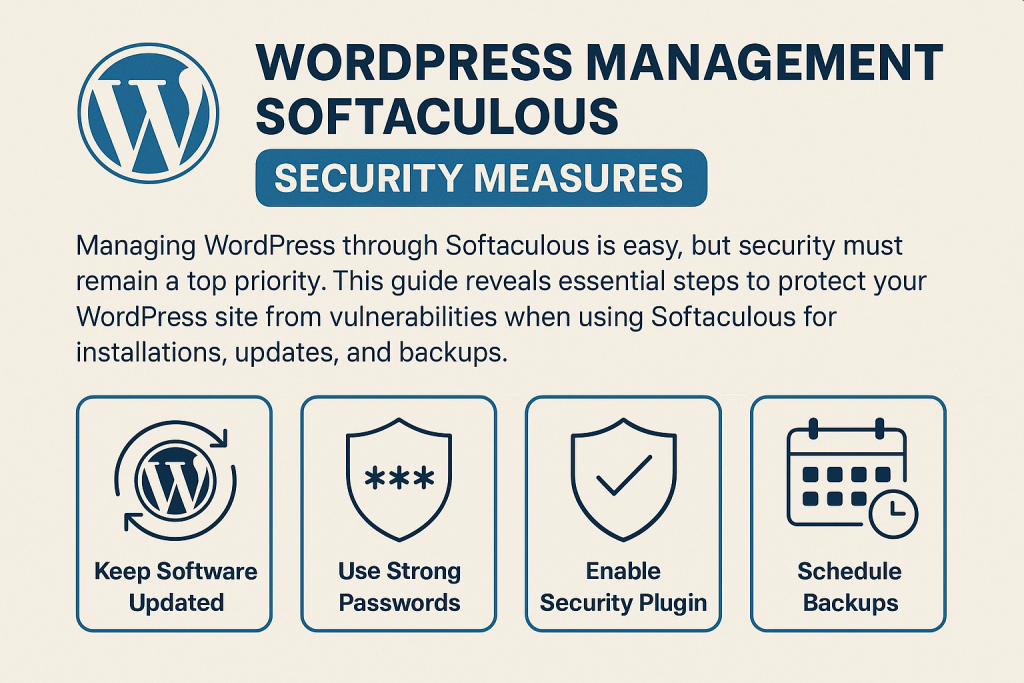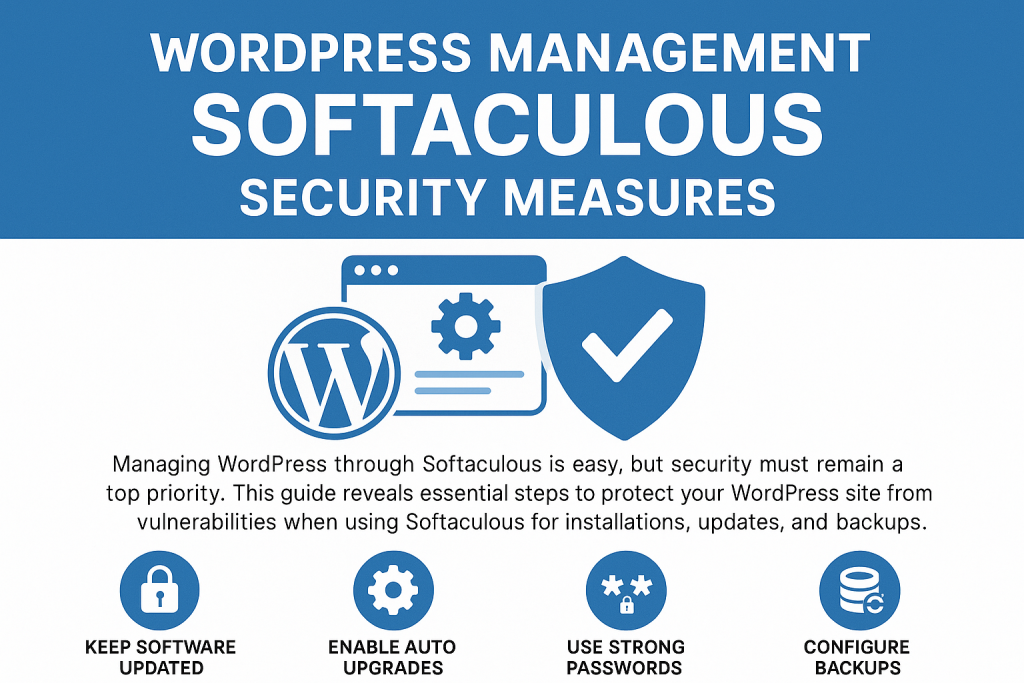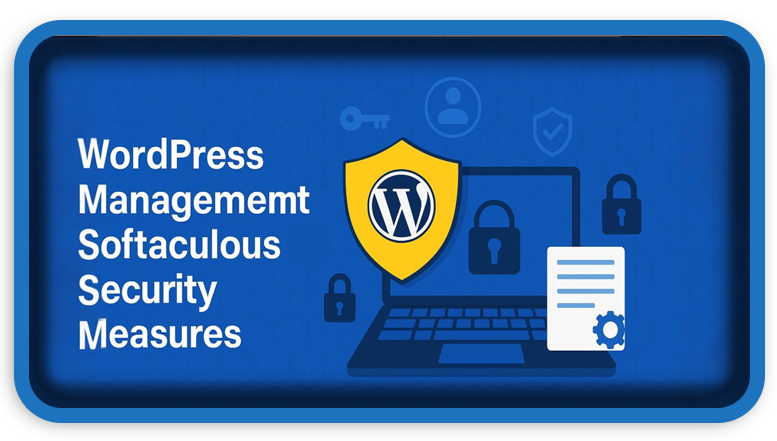⏲️ Estimated reading time: 5 min
WordPress Management Softaculous – Security Measures. Managing WordPress through Softaculous is easy, but security must remain a top priority. This guide reveals essential steps to protect your WordPress site from vulnerabilities when using SF for installations, updates, and backups.
🔐 Why Security Matters in WordPress Management
Softaculous is one of the most popular auto-installers integrated into cPanel and other hosting control panels. It simplifies WordPress installation, cloning, backups, and updates. However, its convenience can become a double-edged sword if proper security measures are not enforced.
In this post, we’ll cover essential WordPress security practices specifically for Softaculous users, ensuring your site remains protected from the growing number of cyber threats in 2025 and beyond.
🛠️ Softaculous Basics: What It Does for WordPress
Softaculous automates many WordPress-related tasks:
- One-click WordPress installation
- Staging and cloning
- Scheduled backups
- Easy plugin and theme installations
- Quick version updates
While it’s a powerful tool, its automation also creates risks if not configured correctly.
🔑 1. Always Use Strong Admin Credentials
When installing WordPress via Softaculous:
- Avoid default usernames like “admin”.
- Use a complex password (mix of uppercase, lowercase, numbers, and symbols).
- Consider using a password manager like LastPass or Bitwarden to generate secure logins.
Why? Brute force attacks are among the top causes of WordPress breaches. Softaculous allows you to set strong credentials at the install stage take advantage of it.

🛡️ 2. Enable Two-Factor Authentication (2FA)
Although Softaculous doesn’t manage 2FA directly, you can install plugins like:
- Wordfence Security
- Two Factor Authentication by WP White Security
Set up 2FA immediately after installation. It’s one of the best defenses against unauthorized logins.
⚙️ 3. Always Use the Latest WordPress Version
Outdated core files are a hacker’s paradise. Softaculous offers:
- Automatic WordPress updates
- Notifications when a new version is available
💡 Enable auto-updates in Softaculous settings to stay secure with minimal effort.
🧱 4. Secure File Permissions After Installation
After installing via Softaculous, review file permissions:
wp-config.php→ 400 or 440/wp-content/→ 755.htaccess→ 444
This ensures sensitive files can’t be tampered with via malware injections or compromised plugins.
🔄 5. Schedule Encrypted Backups
Softaculous makes scheduling backups easy. However:
- Encrypt your backups (if your hosting provider allows it).
- Store backups offsite – use Google Drive, Dropbox, or AWS S3.
Backups are your last line of defense in case of a breach. Softaculous can automate this critical safety net.
🔄 6. Disable WordPress Debug Mode on Live Sites
Softaculous doesn’t turn debug mode on, but it’s worth checking:
- Open
wp-config.php - Ensure this line is present:
define('WP_DEBUG', false);
Why? Debug mode can expose paths, database queries, and other critical data to attackers.
🧩 7. Audit Plugins and Themes Installed via Softaculous
Softaculous lets you install popular plugins and themes instantly. But be cautious:
- Stick to well-maintained themes/plugins with recent updates
- Avoid nulled or unverified themes
- Delete any plugin/theme you don’t use
Malicious or outdated themes are a top attack vector for WordPress hacks.
🚨 8. Monitor for Suspicious Activity
Although Softaculous doesn’t include activity logs, it supports installing security plugins like:
- Sucuri Security
- iThemes Security
These tools can:
- Alert you about file changes
- Track login attempts
- Lock down access after multiple failed logins

🛑 9. Disable XML-RPC (Unless You Use It)
XML-RPC is enabled by default and is often exploited for:
- DDoS attacks
- Brute force attacks via
system.multicall
If you’re not using Jetpack or remote posting tools:
- Disable it using
.htaccess:<Files xmlrpc.php> Order Deny,Allow Deny from all </Files>
📧 10. Configure Email Notifications
Softaculous can send you:
- Installation confirmations
- Update reminders
- Backup reports
Make sure these notifications are enabled so you never miss a critical update or change.
🧬 11. Change the Default wp_ Table Prefix
Hackers often target the default table prefix (wp_). SF allows you to set a custom prefix during installation like:
mywp2025_
Changing this prevents automated SQL injection attacks targeting wp_users, wp_options, etc.
🔍 12. Use an SSL Certificate (HTTPS)
Make sure SF installs your WordPress under HTTPS, not HTTP:
- Check the Protocol field before installation:
✅ Usehttps://instead ofhttp://
SSL protects login credentials and user data from being intercepted.
🧼 13. Harden WordPress with .htaccess Rules
After installation, add custom rules in .htaccess:
# Disable directory browsing
Options -Indexes
# Protect wp-config.php
<files wp-config.php>
order allow,deny
deny from all
</files>
SF creates a basic .htaccess, but hardening it manually is wise.
🔃 14. Use Staging Before Updates
SF allows you to:
- Clone your site
- Test updates on a staging version
- Push live only after verification
This avoids downtime due to broken themes, plugins, or incompatible WordPress versions.
👨💻 15. Keep Softaculous Updated
Yes SF itself gets updates, improving:
- Compatibility with new WordPress releases
- Security of installation scripts
- Backup reliability
Make sure your hosting provider updates Softaculous regularly, or request it if they don’t.
🔁 Essential Routine: Weekly Security Checklist
To make things easy, here’s your Softaculous + WordPress security checklist:
✅ Update WordPress core, themes, and plugins
✅ Review failed logins and activity logs
✅ Check for available Softaculous updates
✅ Confirm backups are working
✅ Scan with Wordfence or Sucuri
✅ Disable and delete unused plugins/themes
🔔For more tutorials like this, consider subscribing to our blog.
📩 Do you have questions or suggestions? Leave a comment or contact us!
🏷️ Tags: WordPress security, Softaculous, WordPress management, website backups, two-factor authentication, staging WordPress, SSL certificate, secure WordPress install, file permissions WordPress, disable xmlrpc
📢 Hashtags: #WordPressSecurity, #Softaculous, #WordPressTips, #WebsiteProtection, #2FA, #SSL, #WPBackups, #StagingSite, #WPPlugins, #CyberSecurity
🧠 Final Thoughts
Using Softaculous for WordPress management is convenient and powerful, but it also demands responsibility. By following these best practices, you transform Softaculous from a simple installer into a central hub for secure, reliable WordPress operations. Don’t leave your site vulnerable take a few minutes to tighten up your defenses today.
Only logged-in users can submit reports.
Discover more from HelpZone
Subscribe to get the latest posts sent to your email.

